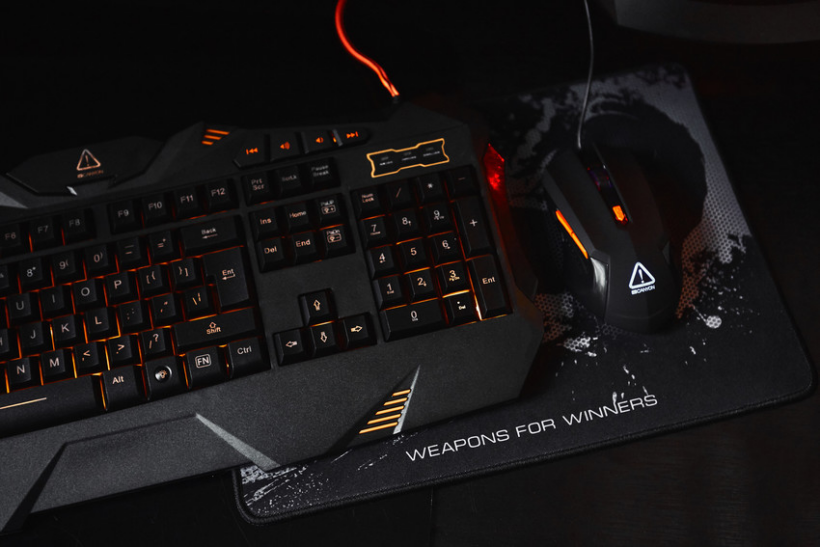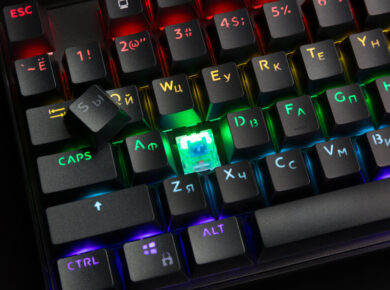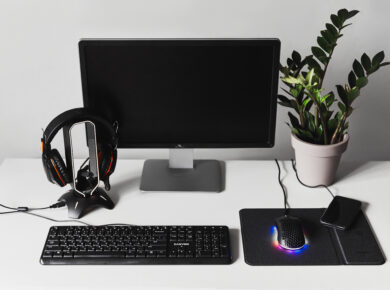Ever wondered why your keyboard looks the way it does? It’s not just a random selection of letters – there’s actually a long story behind it!
So, what is QWERTY? This keyboard, as we know it today, has a complex history. It all started back in the days of typewriters, when things were far less convenient. Believe it or not, but the original design wasn’t meant to be efficient.
Let’s discover the QWERTY keyboard history and why it’s still the go-to for millions around the world.

History of the QWERTY Layout
Back in the late 19th century, typewriters were a big deal. However, they had one major problem: they were prone to jamming. Early typewriters had these little hammers that would hit the ink ribbon and paper to create letters. And when you typed too quickly or pressed the wrong keys, those hammers could get tangled up.
To prevent jamming, inventors came up with the idea of placing frequently used letters farther apart on the keyboard. This way, accidentally hitting two keys at once and causing a jam was less likely. And that’s where the origin of the QWERTY keyboard takes place.
Why QWERTY, what does it mean? The name is simply the first six characters in the top far left row of letters. This arrangement was designed to spread out common letter combinations like “th” and “er” so that they were less likely to jam the typewriter.
It was a smart solution to a mechanical problem, but it also had an unintended consequence: it became the standard for keyboards for decades to come. It’s so ingrained in our minds that it feels natural to us, even though it’s not necessarily the most efficient way to type.

Unique Features & Benefits
The QWERTY layout may have its critics, but it also offers some evident advantages. Here are a few reasons why it’s still popular today:
- Familiarity: Most people have grown up using QWERTY keyboards, so it feels natural and comfortable to them.
- Compatibility: QWERTY is the standard layout for most computers, so compatibility issues are not a thing.
- Software Support: Numerous software applications and typing programs are designed specifically for QWERTY keyboards, making it easier to learn and use.
- Ergonomic Design: Modern QWERTY keyboards often incorporate ergonomic features like curved key layouts and adjustable wrist rests to help prevent strain and discomfort.
- Versatility: QWERTY keyboards can be used for a wide range of tasks, from typing documents to playing games.
While there are other layouts available, QWERTY remains the most widely used and supported option. Its combination of familiarity, compatibility, and versatility has ensured its enduring popularity.

The QWERTY Controversy
While the QWERTY layout has been the dominant standard for decades, its most prominent alternative, Dvorak layout, was designed to be more efficient and ergonomic.
The Dvorak layout rearranges the letters on the keyboard to place frequently used letters under the stronger fingers of the left hand. Supposedly, this reduces finger strain and increases typing speed. However, the Dvorak layout has struggled to gain widespread adoption, partly due to the high cost of switching to a new layout and the lack of software support.
Another criticism of the QWERTY layout is its potential negative impact on user health. Prolonged typing can lead to repetitive strain injuries like carpal tunnel syndrome. While the QWERTY layout is not the sole cause of RSIs, it can contribute to the problem.
To address these concerns, many people have turned to ergonomic keyboards and typing techniques. These tools and methods can help reduce strain on the wrists and fingers, even when using a QWERTY layout.

QWERTY in Popular Culture
The keyboard has become such a mundane part of our lives that it’s easy to forget its cultural significance. It has been featured in countless works of pop culture, becoming a symbol of technology, progress, and the modern world. So, what is a QWERTY keyboard from the perspective of pop culture?
In movies and TV shows:
- The QWERTY keyboard has played a pivotal role in countless hacker scenes, symbolizing technological prowess and mystery.
- It has been used to depict the mundane tasks of office workers, highlighting the repetitive nature of computer-based jobs.
In video games:
- The QWERTY keyboard is essential for controlling characters and performing actions in countless video games.
- It has been used to create iconic sound effects, such as the distinctive “click-clack” sound of typing.
- The device has even been incorporated into the design of video game characters, such as the robot R2-D2 from Star Wars.
In music:
- The QWERTY keyboard has been used to create music, both as a traditional instrument and as a tool for electronic music production.
- Musicians have used it to experiment with new sounds and rhythms, pushing the boundaries of musical expression.

The Future of QWERTY Keyboards
Now, let’s consider the future of the QWERTY layout. As technology continues to evolve, new input methods are emerging that could challenge the relevance of the traditional keyboard.
One such alternative is voice recognition. With advancements in AI and natural language processing, using voice to control computers and other devices gains more popularity. While voice recognition is not yet perfect, it can revolutionize the way we interact with technology.
Another emerging trend is gesture-based controls. By tracking hand movements and gestures, computers can be controlled without the need for a keyboard or mouse. This technology is already being used in devices like smartphones and gaming consoles, and it could eventually become more widespread in other areas of computing.
Despite all this, the QWERTY keyboard is unlikely to disappear. It remains a familiar and versatile tool that is well-suited to many tasks. However, the QWERTY layout may need to adapt to accommodate new input methods and user preferences.
In conclusion, the QWERTY keyboard has a long and fascinating history. From its humble beginnings as a typewriter accessory to its current status as the standard input device for computers, this layout has played a crucial role in shaping the development of technology. While its future may be uncertain, the QWERTY keyboard is likely to remain a fixture in our digital lives for many years to come.







